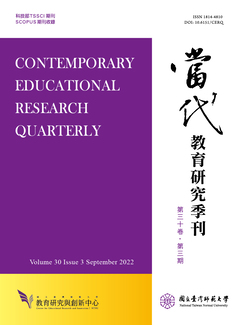

研究目的
本研究旨在探討嬰兒周歲前睡眠節律發展,能否預測他們兩歲的語言成長速度。具體問題有三,嬰兒周歲前睡眠節律出現年紀的個別差異型態?穩定的睡眠節律有助於嬰兒語言能力發展?越早出現睡眠節律的嬰兒,在兩歲的語言成長速度是否也越快?
研究設計/方法/取徑
本研究採用臺灣幼兒發展調查資料庫「3 月齡組」的3、6、12、18 和24 個月五波次調查資料,最後分析納入3563 位嬰兒。採用多層次線性模型建構成長曲線,12、18 及24 個月的語言成長速度為依變項,將3、6 及12 個月睡眠節律動態分成「3 個月前固定」、「3-6 個月固定」、「6-12 個月固定」、「周歲前有變動」四類為獨變項,並控制影響語言發展的其他個人與環境因素。
研究發現或結論
本研究發現嬰兒滿周歲睡眠節律大致穩固,但發展時程呈個別差異性,約六成3 個月大嬰兒已出現睡眠節律,但其中有8% 到周歲前睡眠節律又出現不固定,到6 個月大有八成五嬰兒出現睡眠節律。比較「3 個月前固定」、「3-6 個月固定」、「6-12 個月固定」、「周歲前有變動」四類嬰兒兩歲語言成長速度,結果發現3 個月前睡眠節律固定嬰兒,在第二年的語言成長速度皆顯著快於另外三類嬰兒。
研究原創性/價值
過去研究多探討嬰兒睡眠品質與語言發展的關連性,且對語言能力預測多僅採單一時間點量測,本研究延伸發現嬰兒周歲前睡眠節律動態變化與第二年語言成長速度具關連性。此結果揭示嬰兒早期行為系統發展領域(即睡眠節律),會跨越原領域範疇,與後續另一心智系統(即語言學習)發展呈關聯性。證實睡眠與語言跨領域範疇的「發展級聯」效應在生命早期已出現。
教育政策建議或實務意涵
本研究應用意涵:(1)嬰兒睡眠節律發展大致在周歲前完成,而且他們在周歲前的睡眠節律發展時程呈現明顯個別差異性(2)嬰兒周歲前的睡眠特徵,可考慮納為兒童語言發展評估時的風險因子之一。
Purpose
This study investigated whether infants’ circadian rhythm before 1 year of age would predict their language development between 12 and 24 months of age. Specifically, this study addressed three topics: circadian rhythm development in early infancy, whether the development of the circadian rhythm before 1 year of age would benefit language development at 2 years of age, and whether the language development of newborns with a developed circadian rhythm by 3 months of age would be faster during the second year of life than would that of other newborns.
Design/methodology/approach
This study used five-wave data from the Kids in Taiwan: National Longitudinal Study of Child Development and Care Project. Sleep and language data were collected from infants aged 3, 6, 12, 18, and 24 months. A total of 3,563 participants were included in the final analysis. Multilevel linear models were used to explore the association between the development of the circadian rhythm before 1 year of age and language development at 2 years of age, with demographic factorsand language learning environment controlled for. In these models, circadian rhythm development at 3, 6, and 12 months of age was classified as four categories, “development before 3 months of age”, “development at 3–6 months of age”, “development at 6–12 months of age”, and “change at 1 year of age” to serve as the independent variables. The slope of language development at 12, 18, and 24 months of age was the dependent variable.
Findings/results
Approximately 60% of the participants developed a circadian rhythm by 3 months of age; however, 8% exhibited irregular rhythms at 12 months of age. Those who developed a circadian rhythm by 3 months of age exhibited stronger language skills and faster language development from 12 to 24 months of age than did those who either exhibited an irregular circadian rhythm between 3 and 12 months of age or developed a circadian rhythm at 6 months of age.
Originality/value
This cohort study is one of few to explore the longitudinal associations between the development of the circadian rhythm at 3–12 months of age and language skills at 12–24 months of age, when infants begin to rapidly learn their native language. We discovered that the development of the circadian rhythm before 1 year of age was associated with language development at 2 years of age. The findings indicate a cross-domain developmental cascade between sleep and language during the first 2 years of life.
Suggestions/implications
The circadian rhythm is stable before infants’ first birthdays, and individual variation in circadian rhythm development occurs during the first year. The development of the circadian rhythm could be considered a risk factor in assessments of early language development.

This work is licensed under a Creative Commons Attribution-NonCommercial 3.0 Taiwan License.
Center for Educational Research and Innovation, National Tawain Normal University
162, Ho-Ping East Rd, Sec. 1, Taipei, Taiwan | Tel:+886-2-7749-3670 | E-mail: cerecerq@gmail.com
CERI | NTNU | E-mail Alerts | Open Journal System
© 2014 CERI-NTNU
